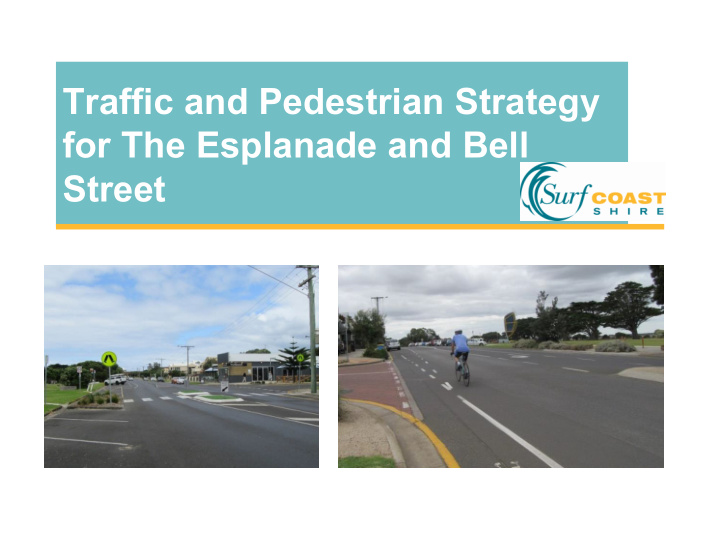



Traffic and Pedestrian Strategy for The Esplanade and Bell Street
Strategy Context • With strong growth in population and visitation, the type and volume of traffic in central Torquay is changing. – Population increase of more than 67 per cent between 2001 and 2013; growth in the surrounding regions such as Armstrong creek and growth in visitation. – 9,000 VPD at peak • The Esplanade and Bell Street as a key beach and entertainment precinct will need to adapt to ensure sustainable access and amenity can be maintained into the future. • Currently reaching unsustainable level over the peak period with conflicts between the needs of pedestrians, traffic, cyclists and events. • Opportune time to consider how the precinct can develop in a sustainable way to support the changing access priorities and pressures.
Strategy Context • The current strategy looks at the short to medium term picture – How can the Esplanade and Bell Street grow/ adapt to meet the challenges over the next ten years and in line with community expectations concerns? • The current strategy needs to also set a direction that will allow sustainable management of the precinct in the long term. How do we set the vision for this precinct– for example will the long term access to the beaches be by bus/ train & shuttle? • If growth continues in line with data projections (population of between 25,000 and 28,000 by 2040) maintaining cars as the primary mode of transport to this precinct will is unlikely to be viable in the long term.
Project Scope In January a group of key internal Stakeholders met to agree the project scope including representatives from Engineering Services, Strategic Planning and Economic Development and it was planned to achieve the following: Develop an independent strategy and costed action plan to facilitate improved pedestrian connectivity, traffic flow and road safety in the precinct over the next ten years. Consider options to support international cycling events and growing events in precinct.
Traffic and Pedestrian Strategy for The Esplanade and Bell Street Proposed Strategy The Traffic and Pedestrian Strategy aims to provide an environment where traffic movement is secondary to pedestrian accessibility and cycling. • Over time, this approach would provide improved opportunities for walking and cycling and greater connection between the town centre and the foreshore.
Study Area 1 : The Esplanade From Zeally Bay Rd to Bell Street
Actions Undertaken To Date O’Brien Engagement Data Review Draft Report Traffic with Key undertaken Developed Engaged Stakeholders Brief as circulated to Discussions held with Stakeholders: Cameron Group Pedestrian counts, currently undertaking Summary of key issues Strategic Planning, traffic counts and crash review of the Town identified Economic Development statistics Centre Access and and Tourism, Engineering Parking Strategy Services. Incorporation of community feedback collated during Recommendations Additional relevant review of Torquay regarding the strategic strategies reviewed Towncentre Parking and improvement of the Esplanade and Bell Street Access Strategy Including Pathway Discussions with Strategy and Town representatives relating to Draft costed action plan Centre Parking and Cadel Evans Great Ocean developed Access Strategy Road Race
roundabout with zebra crossings and bicycle sharrows future kerb outstands zebra crossings zebra crossings kerb outstands zebra crossings kerb outstands zebra crossings and bicycle sharrows zebra crossings and bicycle sharrows kerb outstands, kerb ramps construct path
31
Financial Implications • Long term cost to deliver all • Next financial year there is a $46,000 recommendations would be allocation under the ‘Local Area Traffic $1,076,000. Management, Parking and Pedestrian Improvements’ budget. • High priority actions under the strategy would have a total cost to Council of $220,000. Priority 1: • Potential grant opportunities which Recurrent Budgets could be pursued include ‘Transport Investing in Regions Initiative’ and TAC Community and Local Government External Grant grants’. Funding • TAC grant closes in August 2017 offers up to $100,000 funding if Council provides matched funding – total Priority 2 : $200,000. Funding Bids/ External Sources
Removable Versus Permanent Infrastructure If Council wishes to provide an infrastructure free corridor to support the Cadel Evans Great Ocean Road and future potential events in the precinct it will be necessary to install removable infrastructure north of Price Street. The annual cost implication of removal and replacement of such infrastructure each year is as follows: • Removable islands at Gilbert Street, Anderson Street and Price Street would have an annual cost of $17,500 for removal and replacement each year to support event. • Removable roundabout would have an annual cost of $7,500 for removal and replacement each year. An alternative option would be a flat top roundabout. • Removable infrastructure is expected to have a shorter lifespan and require replacement approximately every 10 years. The cost of replacement of a removable island pair at current market value is $5,000. (i.e. $15,000). Concrete infrastructure has an expected lifespan of 30 years with a replacement cost of $10,000 every 30 years.
ANY QUESTIONS?
Recommend
More recommend